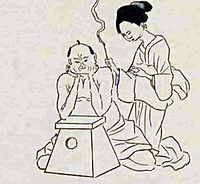Moxibustion

Moxibustion
From Wikipedia, the free encyclopedia Jump to: navigation, search
Moxibustion
Moxibustion (Chinese: 灸; pinyin: jiǔ) is a traditional Chinese medicine therapy using moxa, or mugwort herb. It plays an important role in the traditional medical systems of China, Japan, Korea, Vietnam, Tibet, and Mongolia. Suppliers usually age the mugwort and grind it up to a fluff; practitioners burn the fluff or process it further into a stick that resembles a (non-smokable) cigar. They can use it indirectly, with acupuncture needles, or sometimes burn it on a patient's skin.
Contents
[hide]
1 Terminology
2 Theory and practice
3 Parallel uses of mugwort
4 See also
5 References
6 External links
[edit] Terminology
The word "moxa" comes from Japanese mogusa (艾) (the u is not very strongly enunciated). Yomogi (蓬) also serves as a synonym for moxa in Japan. Chinese uses the same character as mogusa, but pronounced differently: ài, also called àiróng (艾絨)(meaning "velvet of ài").
The Chinese character for moxibustion forms one half of the two making up the Chinese word that often gets translated as "acupuncture" zhēnjiǔ (針灸).
[edit] Theory and practice
Practitioners use moxa to warm regions and acupuncture points with the intention of stimulating circulation through the points and inducing a smoother flow of blood and qi. It is believed by some, for example at Mugwort (Encyclopedia of Alternative Medicine by Clare Hanrahan), that mugwort acts as an emmenagogue, meaning that it stimulates blood-flow in the pelvic area and uterus. It is claimed that moxibustion militates against cold and dampness in the body and can serve to turn breech babies [1]
Medical historians believe that moxibustion pre-dated acupuncture, and needling came to supplement moxa after the 2nd century BC. Different schools of acupuncture use moxa in varying degrees. For example, a 5-elements acupuncturist will use moxa directly on the skin, whilst a TCM-style practitioner will use rolls of moxa and hold them over the point treated. It can also be burnt atop a fine slice of ginger root to prevent scarring.[citation needed]

traditional moxibustion set from Ibuki (Japan)
Practitioners consider moxibustion to be especially effective in the treatment of chronic problems, "deficient conditions" (weakness), and gerontology. Bian Que (fl. circa 500 BC), one of the most famous semi-legendary doctors of Chinese antiquity and the first specialist in moxibustion, discussed the benefits of moxa over acupuncture in his classic work. He asserted that moxa could add new energy to the body and could treat both excess and deficient conditions. On the other hand, he advised against the use of acupuncture in an already deficient (weak) patient, on the grounds that needle manipulation would leak too much energy.[citation needed]
A huge classical work, Gao Huang Shu (膏肓俞), specialises solely in treatment indications for moxa on a single point (穴).[citation needed]
Note that Taoists use scarring moxibustion along with Chinese medical astrology for longevity.
Practitioners may use acupuncture needles made of various materials in combination with moxa, depending on the direction of qi flow they wish to stimulate.
The overwhelming majority of these claims are poorly supported or entirely unsubstantiated by clinical, anatomic, or other basic science evidence. Meta-analysis of the current evidence regarding moxibustion in treatment for ulcerative colitis concluded that evidence is insufficient to show that moxibustion is an effective treatment.[2]
[edit] Parallel uses of mugwort
In many religions of North and South America that pre-date European colonization, mugwort is regarded as a sacred plant of divination and spiritual healing, as well as a panacea. Mugwort amongst other herbs were often bound into smudge sticks. Europeans placed sprigs of mugwort under pillows to provoke dreams; and the herb had associations with the practice of magic in Anglo-Saxon times.[citation needed
